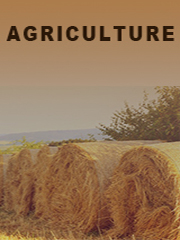Prebiotics in Animal Feed has been shown to benefit digestion, animal performance and the immune system. The microbe population of the rumen must be healthy and in appropriate numbers/balance for proper digestion of feed, and health of the animal.
Prebiotics are fibers which cannot be absorbed or broken down by the body and therefore serve as a great food source for probiotics, in particular the Bifidobacteria genus, to increase in numbers. Prebiotics by nature do not stimulate the growth of bad bacteria or other pathogens; the official definition of prebiotics is: "non-digestible food ingredients that beneficially affect the host by selectively stimulating the growth and/or activity of one or a limited number of bacteria in the colon, which can improve host health."
Prebiotics and probiotics are easily confused. Not only are the names similar, but they are both related to the good bacteria we all need to maintain good digestive health. However, that's where the similarity ends.
This report aims to provide a comprehensive presentation of the global market for Feed Prebiotics, with both quantitative and qualitative analysis, to help readers develop business/growth strategies, assess the market competitive situation, analyze their position in the current marketplace, and make informed business decisions regarding Feed Prebiotics. This report contains market size and forecasts of Feed Prebiotics in global, including the following market information:
- Global Feed Prebiotics Market Revenue, 2018-2023, 2024-2029, ($ millions)
- Global Feed Prebiotics Market Sales, 2018-2023, 2024-2029, (MT)
- Global top five Feed Prebiotics companies in 2022 (%)
The global Feed Prebiotics market was valued at US$ 27 million in 2022 and is projected to reach US$ 37 million by 2029, at a CAGR of 4.6% during the forecast period. The influence of COVID-19 and the Russia-Ukraine War were considered while estimating market sizes.
Beneo, Baolingbao, Sensus, Meiji, Hayashiabara, Longlive and Nikon Shikuhin KaKo are major players in the global market. In 2019, Beneo is a global market leader with a global market share of 18%.
We surveyed the Feed Prebiotics manufacturers, suppliers, distributors and industry experts on this industry, involving the sales, revenue, demand, price change, product type, recent development and plan, industry trends, drivers, challenges, obstacles, and potential risks.
Total Market by Segment:
Global Feed Prebiotics Market, by Type, 2018-2023, 2024-2029 ($ Millions) & (MT)
Global Feed Prebiotics Market Segment Percentages, by Type, 2022 (%)
- Inulin
- Fructooligosaccharide
- Isomaltooligosaccharide
- Others
Global Feed Prebiotics Market, by Application, 2018-2023, 2024-2029 ($ Millions) & (MT)
Global Feed Prebiotics Market Segment Percentages, by Application, 2022 (%)
- Poultry Feeds
- Ruminant Feeds
- Pig Feeds
- Aquaculture Feeds
- Others
Global Feed Prebiotics Market, By Region and Country, 2018-2023, 2024-2029 ($ Millions) & (MT)
Global Feed Prebiotics Market Segment Percentages, By Region and Country, 2022 (%)
- North America
- US
- Canada
- Mexico
- Europe
- Germany
- France
- U.K.
- Italy
- Russia
- Nordic Countries
- Benelux
- Rest of Europe
- Asia
- China
- Japan
- South Korea
- Southeast Asia
- India
- Rest of Asia
- South America
- Brazil
- Argentina
- Rest of South America
- Middle East & Africa
- Turkey
- Israel
- Saudi Arabia
- UAE
- Rest of Middle East & Africa
Competitor Analysis
The report also provides analysis of leading market participants including:
- Key companies Feed Prebiotics revenues in global market, 2018-2023 (Estimated), ($ millions)
- Key companies Feed Prebiotics revenues share in global market, 2022 (%)
- Key companies Feed Prebiotics sales in global market, 2018-2023 (Estimated), (MT)
- Key companies Feed Prebiotics sales share in global market, 2022 (%)
Further, the report presents profiles of competitors in the market, key players include:
- Beneo
- Baolingbao
- Sensus
- Meiji
- Hayashiabara
- Longlive
- Nikon Shikuhin KaKo
- Cosucra
- QHT
- Ingredion
- NFBC
Outline of Major Chapters:
- Chapter 1: Introduces the definition of Feed Prebiotics, market overview.
- Chapter 2: Global Feed Prebiotics market size in revenue and volume.
- Chapter 3: Detailed analysis of Feed Prebiotics manufacturers competitive landscape, price, sales and revenue market share, latest development plan, merger, and acquisition information, etc.
- Chapter 4: Provides the analysis of various market segments by type, covering the market size and development potential of each market segment, to help readers find the blue ocean market in different market segments.
- Chapter 5: Provides the analysis of various market segments by application, covering the market size and development potential of each market segment, to help readers find the blue ocean market in different downstream markets.
- Chapter 6: Sales of Feed Prebiotics in regional level and country level. It provides a quantitative analysis of the market size and development potential of each region and its main countries and introduces the market development, future development prospects, market space of each country in the world.
- Chapter 7: Provides profiles of key players, introducing the basic situation of the main companies in the market in detail, including product sales, revenue, price, gross margin, product introduction, recent development, etc.
- Chapter 8: Global Feed Prebiotics capacity by region & country.
- Chapter 9: Introduces the market dynamics, latest developments of the market, the driving factors and restrictive factors of the market, the challenges and risks faced by manufacturers in the industry, and the analysis of relevant policies in the industry.
- Chapter 10: Analysis of industrial chain, including the upstream and downstream of the industry.
- Chapter 11: The main points and conclusions of the report.
